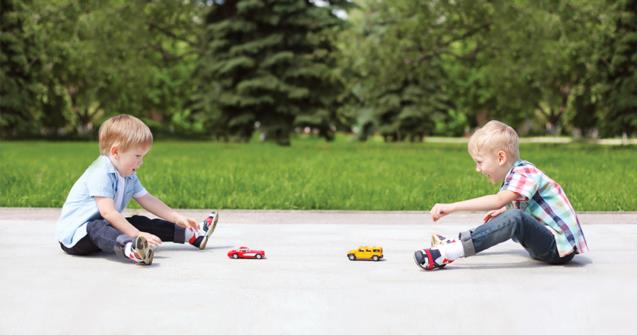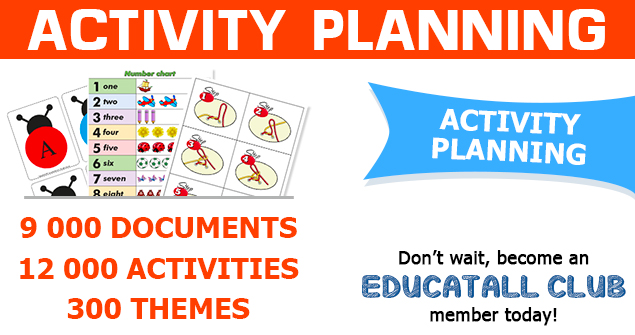
Organizing outdoor workshops
I am sure you have already heard of workshops and corners also known as play areas, divisions, or even learning centres. All these terms are synonyms that mean different play stations presented in your daycare.
We are all familiar with these corners indoors, but very few early childhood educators present them outdoors in spite of the fact that most corners can be adapted to your yard. This type of organization also makes it easier to observe the children in your group and keep them busy. Obviously, the same outdoor corners cannot be offered in every daycare since each yard has its own limitations and characteristics. Various methods can be used to delimit outdoor corners: cones, ropes, or lines drawn with chalk on hard surfaces.
Here are a few ideas of corners that can be presented outdoors during summer months. You may choose to offer them every day or only for a day or two per week.
Construction/building blocks
This corner is perfect for outdoor play in your backyard, on a sidewalk, or on a porch. Set an old car mat (with roads drawn on it), a few cars, and plastic or wooden building blocks on the ground and children will have fun for hours.
This is also the perfect time to present noisy means of transportation. We all have tiny cars and trucks children love to play with that are too noisy for indoor play. Their sounds will be easier to tolerate outdoors and children will appreciate playing with them.
Arts & crafts
The arts & crafts corner is also easy to take outdoors. I use a mobile utility cart with three drawers that can easily be stored in a shed. I fill this cart with recycled paper, coloring pages, markers, scraps of construction paper, scissors, and glue.
You can hang a white banner on a fence and encourage children to make a collective mural. Suggest a theme or let them create freely. Hanging pieces of Coroplast on your fence can also provide an interesting surface children can paint or color. Use your hose to clean it and provide a clean slate. Children can start over as often as they wish.
Sidewalk chalk can also be integrated here. If your yard boasts a sidewalk or asphalt in one area, children will enjoy drawing their imaginary world, their family, or simply the bug they captured just a few minutes ago.
Role play
A bin filled with clothing items, handbags, shoes, and hats you have collected here and there (ask parents for items they no longer need, visit your local thrift shop, etc.) is sure to please your group.
You can also bring your plastic kitchen outside. Children will love to prepare their own barbecued food. Add a few accessories and summer-themed items (empty ketchup and mustard bottles, barbecue tongs, a tablecloth, a picnic basket, etc.) to completely transform this corner.
A puppet theatre can also easily be taken outside. Set it in a shady area and children will be glad to prepare and present a variety of puppet shows.
Pre-reading
A reading corner can be exploited in a variety of different ways in your backyard. You just have to be creative!
- A container filled with books related to your current theme or books about children's favorite heroes and a small picnic table suffice. If you wish, add figurines children can use to act out different stories.
- Wrap books with soft blankets. Just use two pieces of ribbon to imprison a few books inside each blanket.
- A small foldable tent is the perfect place to deposit a few books adapted to the ages of the children in your group.
- A 3-drawer mobile utility cart can easily be filled with books.
Since no two groups are exactly alike, experiment to discover what works best for your group.
Early science
Days spent outdoors are ideal for exploring science. Children are sure to make a wide range of discoveries each day, from worms to a nest. Here are a few suggestions to spark their interest:
- Containers and real insects captured in your yard (or plastic insects).
- Magnifying glasses and objects from nature found in your yard or when taking a walk.
- Binoculars for observing birds.
- Butterfly nets.
Gardening
If you are lucky enough to have a small area that can be devoted to gardening in your yard, it will represent a great way to introduce your group to nature and develop their sense of responsibility. Even if planting a garden in your yard is impossible, you can fill a few containers with soil or pretend to plant vegetables in your yard. Here are a few items that can make your gardening corner attractive for little ones:
- Watering cans, rakes, gardening gloves.
- Sticks and pictures for identifying plants.
- Sun hats.
- Gardening magazines, plastic vegetables and flowers, small flower pots, etc.
Bike path corner
Is a section of your yard paved? Use it to create a bike path for tricycles, bicycles, scooters, and doll strollers. Have fun tracing lines on the ground to direct traffic. Add road signs and a pretend gas station. Children will have fun driving around in this area.
Sand corner
Your sand corner (or sandbox) represents a gigantic sensory bin. Add different accessories throughout the summer to make it even more interesting for your group:
- Of course, every sandbox must contain buckets and shovels. Empty yogurt containers or other recycled containers are perfect substitutions for traditional sand buckets and pails.
- Sieves, moulds, and small sand mills.
- Metal tablespoons.
- Trucks and small cars.
- Plastic animals or dinosaurs.
- Old kitchen and plastic dishes.
- Add your hose on a hot summer day to turn it into a mud bin!
Water corner
Of course, on very hot days, small pools are perfect for cooling off. However, a water corner can be offered early in the season too. Simply set a few containers filled with water on a low table and children will have plenty of fun. They can cool off without getting wet from head to toe. Here are a few suggestions:
- Plastic animals and figurines.
- Small boats or objects that float.
- Funnels and sieves.
- Sponges.
Motor skills
Your yard is THE perfect place for developing children's motor skills. Your only limit is children's safety. Use your imagination to create a variety of different obstacle courses. Use any material you have on hand to challenge children's motor skills.
- Tunnel.
- Balance beam.
- Parachute.
- Hula hoops.
- Colourful adhesive tape.
- Colourful shapes.
- Tables and chairs.
Summer months often represent a period of increased free play when no particular theme is explored. Organizing your yard to offer different corners and workshops will make it possible to challenge children throughout the summer while spending quality time with them.
Caroline Allard
Educatall.com is not responsible for the content of this article. The information mentioned in this article is the responsibility of the author. Educatall.com shall not be held responsible for any litigation or issues resulting from this article.

 Home
Home Theme activities
Theme activities
 Babies and toddlers
Babies and toddlers
 Arts and crafts
Arts and crafts
 Science
Science
 Creative recipes
Creative recipes
 Tips and tricks
Tips and tricks
 Special needs
Special needs
 Extra activities
Extra activities
 Educ-TV
Educ-TV
 Newsletter
Newsletter  Online store
Online store Educatall club
Educatall club


